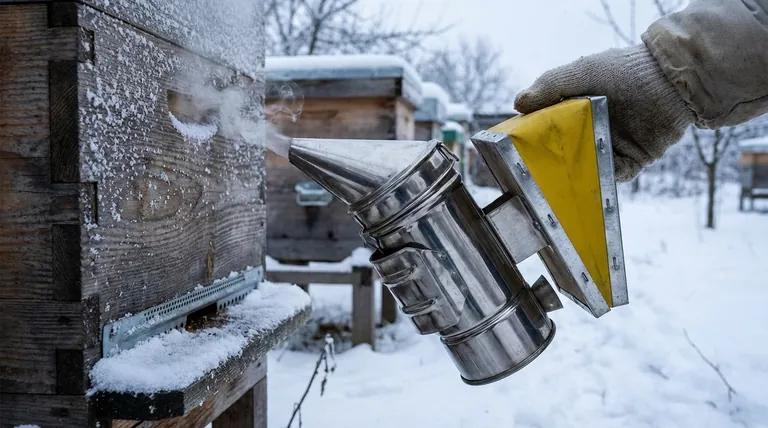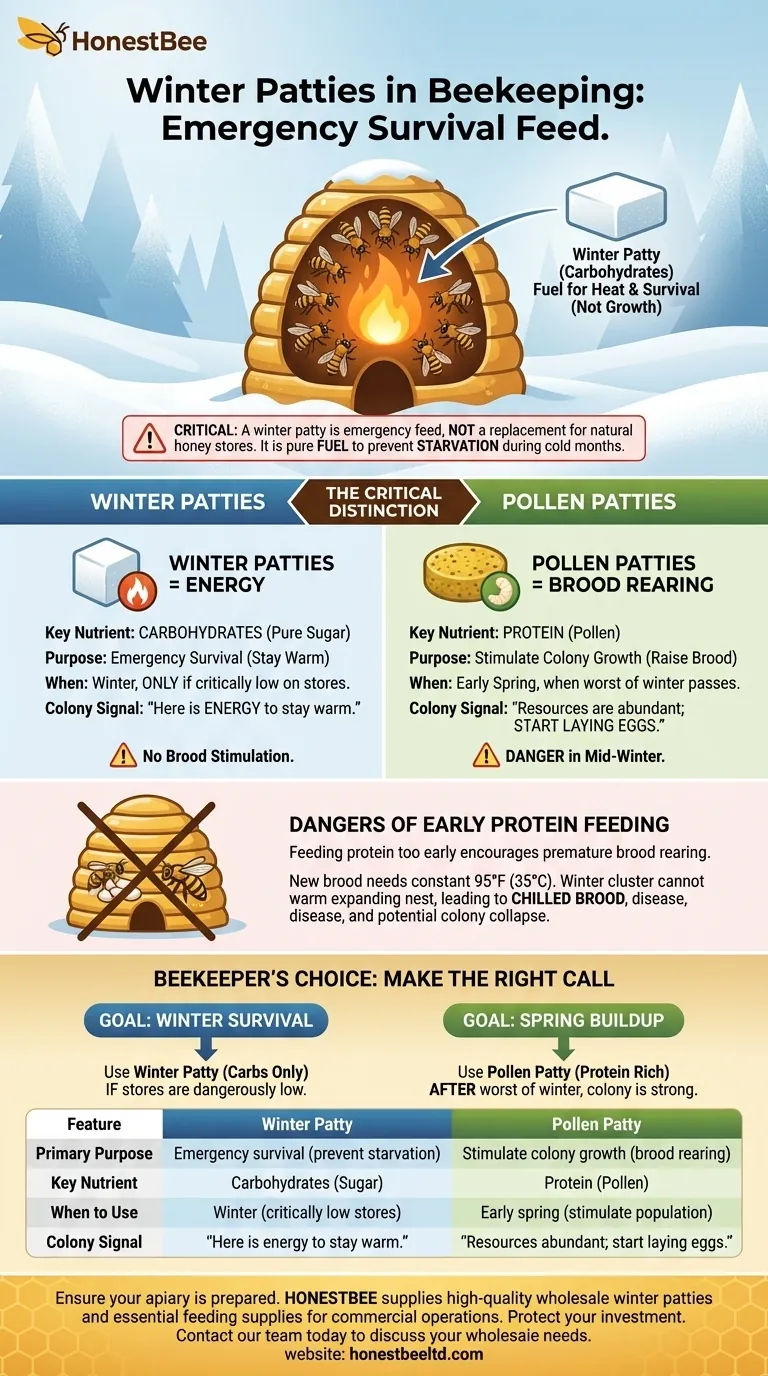In beekeeping, a winter patty is a form of emergency feed used to prevent a honey bee colony from starving during the cold months. It serves as a critical insurance policy when a hive's natural honey stores have been depleted, providing the essential carbohydrates bees need to generate heat and survive until natural forage becomes available again.
The most crucial concept to understand is the difference between a carbohydrate-heavy winter patty for survival and a protein-rich pollen patty for colony growth. Confusing the two is a common and potentially fatal mistake for an overwintering hive.

Understanding the Goal: Winter Survival, Not Growth
A honey bee colony's primary job in winter is to maintain the temperature of its central cluster. This process consumes a tremendous amount of energy, which is fueled by their stored honey.
What is a True Winter Patty?
A winter patty is fundamentally a solid block of sugar, primarily sucrose. It is designed to mimic the energy value of honey without introducing excess moisture or components that stimulate the queen.
These patties provide pure carbohydrates, which the bees metabolize to flex their wing muscles, generating the heat needed to keep the cluster and the queen alive at a stable temperature.
Why is it "Emergency" Feed?
The best food for bees is always the honey they have produced and stored themselves. A winter patty is not a replacement for proper fall feeding or leaving adequate honey stores.
It is an intervention used only when you determine the hive is dangerously light on stores, typically during a brief check on a warmer winter day. Its purpose is singular: preventing starvation.
The Critical Distinction: Carbohydrates vs. Protein
The confusion between patty types is where many beekeepers run into trouble. The ingredients dictate the colony's response, and using the wrong one at the wrong time can be disastrous.
Winter Patties = Energy
Think of a winter patty as pure fuel. It contains carbohydrates (sugar) and nothing else intended to stimulate the colony. It tells the bees, "Here is energy to stay warm and survive."
Pollen Patties = Brood Rearing
A pollen patty, by contrast, is rich in protein and other nutrients. Protein is the key ingredient required to raise new bees (brood).
Feeding a pollen patty sends a powerful signal to the colony that resources are abundant, triggering the queen to begin laying eggs and expand the brood nest.
Understanding the Trade-offs and Dangers
Providing the wrong food source at the wrong time can actively harm your colony. The goal is to support the bees' natural winter cycle, not disrupt it.
The Pitfall of Feeding Protein Too Early
Introducing a pollen patty in mid-winter is a significant mistake. It encourages the queen to start laying eggs long before the colony can manage a larger brood nest.
This new brood requires a constant temperature of around 95°F (35°C). The winter cluster may not have enough bees to generate that much heat and cover the expanding brood area.
The result is often chilled brood, which dies and can introduce disease, placing immense stress on the colony and potentially causing its collapse before spring arrives.
The Downside of Any Winter Feeding
Opening the hive to add a patty, even on a mild day, breaks the hive's propolis seals and can chill the colony. It should only be done when the risk of starvation outweighs the risk of the intervention. The best practice is to ensure the hive is heavy with honey going into winter.
Making the Right Choice for Your Goal
Your feeding strategy must align with the season and the specific needs of your colony.
- If your primary focus is pure winter survival: Use a carbohydrate-only winter patty or sugar block only if you have confirmed the hive is critically low on honey stores.
- If your primary focus is stimulating early spring buildup: Use a protein-rich pollen patty only after the worst of winter has passed and the colony is strong enough to manage and warm a growing brood nest.
Understanding that winter feeding is for energy while spring feeding is for growth is fundamental to becoming a successful beekeeper.
Summary Table:
| Feature | Winter Patty | Pollen Patty |
|---|---|---|
| Primary Purpose | Emergency survival (prevent starvation) | Stimulate colony growth (brood rearing) |
| Key Nutrient | Carbohydrates (Sugar) | Protein (Pollen) |
| When to Use | Winter, when honey stores are critically low | Early spring, to stimulate population growth |
| Colony Signal | "Here is energy to stay warm." | "Resources are abundant; start laying eggs." |
Ensure your apiary is prepared for winter. HONESTBEE supplies commercial apiaries and beekeeping equipment distributors with high-quality winter patties and essential feeding supplies through our wholesale-focused operations. Let us help you protect your investment and ensure your colonies survive until spring. Contact our team today to discuss your wholesale needs.
Visual Guide

Related Products
- Miniature Stainless Steel Bee Smoker for Beekeeping
- Queen Bee Catcher Plastic Bee Marker Bottle with Piston Marking Tube
- High Performance Plastic Queen Excluder for Beekeeping and Apiary Management
- Professional Queen Catcher and Introduction Queen Cage
- Heavy Duty Stainless Steel Queen Bee Catcher Clip
People Also Ask
- What is the proper technique for lighting a bee smoker? Master the Layered Fire Method for Calm Hives
- What type of bee smoker is recommended for beginners? A Guide to Choosing Your First Smoker
- Is a bee smoker necessary? The Essential Tool for Safe and Effective Hive Management
- Why should you avoid over-smoking a hive? Prevent Stress and Protect Honey Quality
- Do bee smokers work on wasps? Why It's a Dangerous Misconception



















